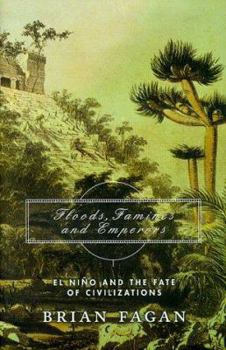Floods, Famines, and Emperors: El Nino and the Fate of Civilizations
Select Format
Select Condition 
Book Overview
In 1997 and early 1998, one of the most powerful El Ninos ever recorded disrupted weather patterns all over the world. Europe suffered through a record freeze as the American West was hit with massive... This description may be from another edition of this product.
Format:Hardcover
Language:English
ISBN:0465011209
ISBN13:9780465011209
Release Date:February 1999
Publisher:Basic Books
Length:304 Pages
Weight:1.24 lbs.
Dimensions:1.2" x 6.4" x 9.6"
Customer Reviews
5 ratings
Must read for global climate information
Published by Thriftbooks.com User , 16 years ago
Little discussed by the main stream, El Nino is shown to be a powerful influence on global weather. Easy to read and understand.
Water, water, everywhere and nowhere
Published by Thriftbooks.com User , 20 years ago
According to Brian Fagan, the phenomenon known as El Nino has abruptly entered our collective awareness. That's a good thing, since its effects have a long, and often disastrous reach. It is not, he contends, the only issue to consider in climate impact. It has been "over-hyped" by media. The issues go beyond freak storms and harsh droughts. Humans have confronted weather throughout their evolutionary history. How society copes with global weather impact is Fagan's real concern. He's collected a wealth of information in this well written account. There is much to learn from this book, which includes some intriguing surprises. Comfortably divided into three major themes, Fagan opens with an explanation of El Nino's "discovery". What had seemed to be freak weather events proved to have an underlying pattern. The El Nino Southern Oscillation [ENSO] is an eastward moving body of warm Pacific Ocean water. The warmth blocks the flow of the Humboldt Current moving from Antarctica along the South American coast. Fish die or depart, with birds duplicating the pattern. Fagan stresses that the effect of that warm cell has global reach and has roots deep in time. Pharonic Egypt felt its impact, perhaps contributing, if not causing, social upheaval and even a new philosophy of rule by those absolute rulers.How society and its rulers deal with abrupt weather change is the focus of the second part. As an anthropologist, Fagan is conversant with ancient societies. He examines the Andean Moche people who engineered extensive irrigation systems to catch feeble rainfall. With El Nino, rainfall changes from feeble to fabulous and the Moche watched their canals being flushed away. The following famines broke the power of the Moche aristocracy and the culture collapsed. A similar fate occurred to the Maya, whose rigid social pattern prevented them from coping with crop loss. However, the Anasazi people of the American Southwest, long skilled in desert agriculture, had a different method for dealing with drought. A loose, flexible society encouraged sharing of resources, then departure when the soil failed. Fagan overturns the long-held view that the Anasazi "mysteriously" disappeared. He contends they simply dispersed. In the final section, Fagan relates some historical climate events such as The Little Ice Age and the Sahel drought. He examines the short-sighted policies that have exacerbated the human impact of such events. Over expansion in good years leaves no flexibility for addressing the needs of bad times. Governments must avoid superficial solutions in the face of knowing climate will generate surprises. Better planning scenarios are required for land occupation and use. Although it's been said before, Fagan urges better understanding of what is sustainable. That, of course, means more research and the application of political will derived from its results. While that may curtail some short-term profit gains and force revision of
Floods, Famines, and Emperors
Published by Thriftbooks.com User , 24 years ago
This was a wonderful treatment of the effects of weather/climate on ancient civilizations. I found the thesis rather intriguing, as I had not considered how compelling might be the effects of major changes in the weather regime on a culture. One is quite aware of local effects of the weather, especially when it is severe. The news media make the statistics of every flood, hurricaine and draught the subject of international interest. Certainly the effects of major climatic disasters like the 7 lean years of the Bible and the Dust Bowl years of US history are familiar. Professor Fagan makes clearer the political and social impact of El Ninos world wide in antiquity as well.
Fagan unfolds historical drama of the "Christmas Child".
Published by Thriftbooks.com User , 25 years ago
Never has one work tied together so much world history with the geologic and geographical weather record to create such a compelling case for the power of El Nino, the "christmas child." Reading this book made me much more aware of the subtle, power of nature working "behind the scenes" The author held my interest throughout and left me contemplating other world events that must also have been influenced by El Nino and La Nina.
Excellent synthesis of climatic concepts and civilizations
Published by Thriftbooks.com User , 25 years ago
As a professional meteorologist, routinely faced with questions on El Nino and La Nina, I found this book both interesting and enjoyable. Like other Fagan books, it was well written and easy to read.Meteorologists and Climatologists will enjoy this book, with simple and historical treatments of Monsoons, ENSO, and the North Atlantic Oscillation. Those with a weather interest will enjoy this book, especially the first 100 page or so.Finally, the book connects the climatological phenomena with civilizations. The climate impacted all civilizations and may have weakened them, contributing the their evolution or demise. These concepts are supported in the text and fit well with the concept on human evolution in Ian Tattersall's book "Becoming Human-Evolution and human uniqueness".This book supplements some of the ice age material in the earlier Fagan book, "The Great Journey-The peopling of ancient America". This book is both easy to read and understand, well worth the cost.





